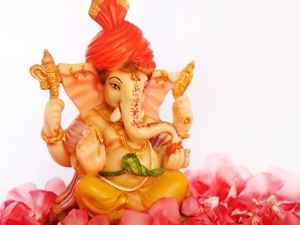
Shutterstock.com
A four armed man with an elephant’s head, this is perhaps one of the best known images in Hinduism. Often shown sitting on a lotus or an impossibly sized mouse, the elephant headed god Ganesha is one of the most recognizable Hindu deities. He is also one of the most important deities in Hinduism.
Honored by all sects of Hinduism, Ganesha is the son of the god Shiva and the goddess Parvati. According to Hindu legend, Ganesha was created when Parvati became dirty after celebrating a festival with Shiva. When she realized that her skin was filthy, she went to take a bath. Before bathing, Parvati removed the dirt from her skin and fashioned it into a boy. She then told him to stand guard while she was bathing.While Parvati was in the bath, Shiva came looking for her. The boy, however, did not let Shiva pass and obstructed his path. Enraged, Shiva cut off the boy’s head and went to Parvati. When Parvati realized what had happened, she was horrified. She explained to Shiva that Ganesha was her son. In response to Parvati’s anguish and anger, Shiva instructed several helpers to locate a person or being who was sleeping with their head pointed north and bring the head to Shiva. The helpers went searching and found an elephant who fit Shiva’s requirements. When they brought the head back, Shiva affixed it to the boy’s torso and revived him. Shiva then made the newly created Ganesha the leader of armies and declared that people would worship Ganesha and invoke his name before than began any venture.
As a deity, Ganesha is also known as Ganesa, Ganesh, Ganapati, Vinayaka and Pillaiyar. He is the Lord of Good Fortune, Lord of Beginnings and Remover of Obstacles. When undertaking a challenge, Hindus will pray to Ganesha and ask him to bless their attempt and remove any obstacles that will keep them from success. Interestingly, Ganesha is a deity who not only removes obstacles, but also creates them in order to keep people in check.
In addition to acting to remove obstacles and help bring prosperity, Ganesha is known as a patron of letters and learning. Elephants in India are associated with unmatched wisdom and knowledge gained through careful listening and reflection. In the myth that depicts Ganesha’s origins, Shiva cuts off Ganesha’s head when he keeps Shiva from Parvati. By impeding Shiva’s progress, the young Ganesha was acting as the force of ignorance which keeps out divine wisdom and enlightenment. Ignorance is associated with the mind. By losing his head, Ganesha lost his ignorance and had it replaced with an elephant’s wisdom. When Ganesha grew older, legend has it that Ganesha was the first scribe to write down the epic poem the Mahabharata. According to the tale, Ganesha was writing down the epic as it was dictated to him by the sage Vyasa. Halfway through the dictation, Ganesha’s pen snapped. Unwilling to force Vyasa to pause and interrupt the transcription or to risk missing part of the story, Ganesha snapped off one of his tusks and used it as a replacement pen. He is usually depicted holding this broken tusk in Indian art. The broken tusk underscores Ganesha’s role as a patron of the arts and of learning. It is also seen as symbolic of willing sacrifices, especially those made in pursuit of artistic endeavors.
In addition to the association of Ganesha with elephants, for obvious reasons, he is also often linked with mice. In Hinduism, many deities are seen as having a particular animal that acts as the vahana or vehicle that carries the god or goddess to wherever they need or wish to go. Ganesha’s vahana is a mouse. It seems odd to put a deity with the head of an elephant on the back of the mouse, but the mouse is actually seen as underscoring Ganesha’s connection with knowledge and the removal of obstacles. An elephant is not impeded by obstacles because of its enormous size. They simply push through barriers and keep walking forward effortlessly. A mouse, on the other hand, can easily be blocked by a small barrier. That said, a mouse can slide through even the smallest of cracks and reach places an elephant cannot. When caught by strong ropes, an elephant will be trapped it if cannot yank itself free. A mouse, however, will slowly gnaw its way through the binding and escape. As such, elephants are associated with the effortless and unrelenting pursuit of enlightenment. A mouse, however, represents the hard work that is needed to cut through the many things that tie a person to ignorance and keep them from reaching wisdom and enlightenment.
Like many Hindu deities, portrayals and stories about Ganesha are filled with layers of symbolism. The combination of the elephant and mouse represents how Ganesha can remove obstacles of any size. His large belly stands for generosity and total acceptance. He is associated with successes, learning and wisdom. As such, it is no wonder that statues of Ganesha are so commonly found in Indian homes and places of business. He is a deity that anyone would want on their side.

